
“It is one of a handful of animation masterpieces and likely the most cerebral of them. Daffy makes the most of his opportunity for a definitive solo tour de force. It is at once a laugh riot and an essay by demonstration on the nature and condition of the animated film and the mechanics of film in general.”
So said Richard Thompson of Duck Amuck in Film Comment in 1975. Ranked at number two in Jerry Beck’s book, The 50 Greatest Cartoons as Selected by 1,000 Animation Professionals (Bugs Bunny’s What’s Opera, Doc? was just a “hare” above it at number one), Duck Amuck encapsulates all that we love about animation.
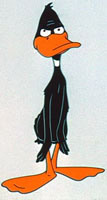 Sharp, creative, true to its main character, and “meta,”; Duck Amuck is most deserving of its ranking among cartoons, as well as the additional accolades and praise heaped upon this Warner Bros. Daffy Duck short since its debut.
Sharp, creative, true to its main character, and “meta,”; Duck Amuck is most deserving of its ranking among cartoons, as well as the additional accolades and praise heaped upon this Warner Bros. Daffy Duck short since its debut.
It is no surprise that Duck Amuck came to us from the genius of Chuck Jones. An animation director who brought perfect comic timing to his films and was also unafraid to stretch expectations for cartoons beyond their limits.
In addition to What’s Opera, Doc?, some of his other grand experiments include 1942’s The Dover Boys at Pimento University; or the Rivals of Roquefort Hall, and 1965’s The Dot and The Line.
Duck Amuck plays with the main character’s and the audience’s expectations for the entire short subject.
The short begins with a sleight of hand, featuring credits and an opening that makes us think we are about to see Daffy in a swashbuckling musketeer short. As Daffy brandishes his sword, he suddenly runs out of backgrounds (by two more legends, Philip DeGuard, and Maurice Noble) and finds himself bewildered in front of a white screen.
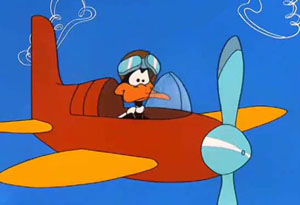 “Psst, Hey,” whispers Daffy to the camera, “whoever is in charge here. The scenery! Where’s the scenery?”
“Psst, Hey,” whispers Daffy to the camera, “whoever is in charge here. The scenery! Where’s the scenery?”
A paintbrush appears and creates a barnyard backdrop. Daffy begrudgingly pops off the screen and changes into a farmer’s outfit. He sings a modified version of “Old MacDonald,” but then he comes across a wintry scene with an igloo. Growing frustrated, he changes outfits again and begins singing “Jingle Bells.” But then, the background changes again to a Polynesian theme. So, Daffy sports a sarong and begins singing “Farwell to Thee.”
And then, the backdrop tapers away, and we return to a white screen. Daffy turns his slow burn to the camera, lecturing the cartoon’s creator about how the scenery is needed. A giant pencil and eraser appear, quickly erasing Daffy off the screen.
“Alright, wise guy! Where am I?!” demands disembodied Daffy, after which he is re-drawn and painted as a cowboy with a guitar. When Daffy attempts to strum the guitar, nothing happens. He holds up a sign that reads: “Sound, Please!” When he tries to play again, the guitar sounds like a machine gun and a car horn. Daffy smashes the guitar, but random bird sounds come out of his mouth when he tries to protest.
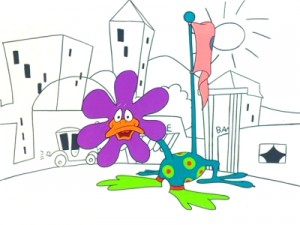 In true Daffy style, he then says to whoever is doing this to him, “Listen, Mac, what’s going on around here? Let’s get organized, hmm? How about some scenery.”
In true Daffy style, he then says to whoever is doing this to him, “Listen, Mac, what’s going on around here? Let’s get organized, hmm? How about some scenery.”
The creator obliges, scribbling backgrounds that look like a child scrawled them, and when Daffy asks for color, he gets painted with a paintbrush. When Daffy loses it, an eraser appears and erases all but his eyes and bill and re-paints a new body for him: a flower-like head, a polka-dot, platypus body, bird-like rear legs, and a tail with a flag on it. And on that flag? A picture of a “screw” and a “ball.”
When Daffy gets a look at himself, he demands to be re-drawn, and when he is, it’s as a sailor. He’s excited to be in a “sea picture” until the background of water and an island is painted without a boat!
Beyond exasperated, Daffy tries to reason with the person behind this, but the scenery collapses. He then, once again, completely loses it, and tears the scenery apart.
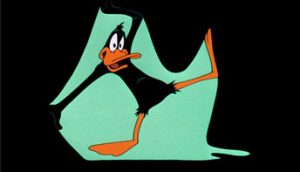 A “The End” title card then appears. Daffy screams, “No! No,” and pushes it out of the way, attempting to reason with whoever is in charge. He then tries a soft shoe number but soon finds himself arguing with his double and as a pilot in a plane that crashes into the side of a mountain.
A “The End” title card then appears. Daffy screams, “No! No,” and pushes it out of the way, attempting to reason with whoever is in charge. He then tries a soft shoe number but soon finds himself arguing with his double and as a pilot in a plane that crashes into the side of a mountain.
As he tries to parachute to safety, his parachute is erased and replaced with an anvil, which is then replaced with a bomb, which, of course, explodes.
Daffy then attempts the last plea, asking, “Who is responsible for this?!?” A door is drawn in front of Daffy and closes. As the camera pulls out, we see an animator’s desk, and the person responsible sitting at it is…
…spoiler (?)…
…Bugs Bunny, who laughs and declares, “Ain’t I a stinker?” before the credits roll.
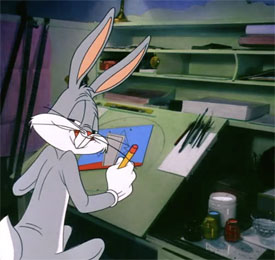 In less than seven minutes, Duck Amuck packs in everything we have come to expect from Warner Bros. cartoons (and cartoons, in general), in addition to being an innovative twist on the classic Bugs and Daffy rivalry.
In less than seven minutes, Duck Amuck packs in everything we have come to expect from Warner Bros. cartoons (and cartoons, in general), in addition to being an innovative twist on the classic Bugs and Daffy rivalry.
Released on February 28th, 1953, Duck Amuck, celebrating its 70th anniversary this year, deserves the admiration and praise it has received as one of the pinnacles of Warner Bros. Animation and of the medium.
As author Charles Solomon noted in his book, Enchanted Drawings: The History of Animation, the short has been studied in depth by many throughout the years. Charles wrote: “Duck Amuck has been widely discussed by critics, who see it as an existential parable, open to interpretation on many levels.”
The director of Duck Amuck, Chuck Jones, and his team of artists crafted such a masterful cartoon because they knew the main character so well. In his book Chuck Reducks, he noted: “The more you know Daffy, the better you like him because you are going to recognize yourself.”


 Michael Lyons is a freelance writer, specializing in film, television, and pop culture. He is the author of the book, Drawn to Greatness: Disney’s Animation Renaissance, which chronicles the amazing growth at the Disney animation studio in the 1990s. In addition to Animation Scoop and Cartoon Research, he has contributed to Remind Magazine, Cinefantastique, Animation World Network and Disney Magazine. He also writes a blog, Screen Saver: A Retro Review of TV Shows and Movies of Yesteryear and his interviews with a number of animation legends have been featured in several volumes of the books, Walt’s People. You can visit Michael’s web site Words From Lyons at:
Michael Lyons is a freelance writer, specializing in film, television, and pop culture. He is the author of the book, Drawn to Greatness: Disney’s Animation Renaissance, which chronicles the amazing growth at the Disney animation studio in the 1990s. In addition to Animation Scoop and Cartoon Research, he has contributed to Remind Magazine, Cinefantastique, Animation World Network and Disney Magazine. He also writes a blog, Screen Saver: A Retro Review of TV Shows and Movies of Yesteryear and his interviews with a number of animation legends have been featured in several volumes of the books, Walt’s People. You can visit Michael’s web site Words From Lyons at: 






















I was probably first introduced to this cartoon through “Bugs Bunny show“, and I am so glad it is now out there as restoration. out of all the Looney Tunes characters, I think daffy duck has gone through the most changes. We know what those changes are, so I don’t need to outline them here, but he is a character that proves that even cartoon characters “grow up“, or grow older and change their viewpoint of life, even within an animated cartoon. This is truly one of the best.
“Duck Amuck” explores the concept of the cartoonist as God, capable of creating whole worlds at will, yet whose sentient creations, imbued with life, take on a will of their own. Despite the innumerable indignities to which he is subjected, Daffy remains essentially Daffy. His physical appearance and external circumstances can be altered, but his essential nature is inviolate. There’s got to be a sermon in that somewhere.
It’s strange that the “Duck Amuck” lobby card, showing what is unmistakably Bugs’s white-gloved hand holding the pen, gives away the ending of the cartoon.
“Duck Amuck” inspired a number of other cartoons, not least of which is Jones’s own “Rabbit Rampage” of 1955. That same year, Paul Terry released “Foxed by a Fox”, in which a fox takes the cartoonist’s pencil and eraser and uses them to torment a hunter and his dog — quite a funny and imaginative Tyer-era Terrytoon.
It seemed obvious that the Terrrytoons staff saw “Duck Amuck” and wanted to try to have a piece of that action.
As I’ve said before, it’s easy to take this cartoon for granted because it’s been replayed so much and its fourth wall ideas have been copied many times over (including by the same studio), but really… it’s still one of Chuck Jones’s best.
On a related note, check out the Bugs Bunny: Lost in Time commercial – it uses the same premise but instead of Bugs drawing the Daffy cartoon, he’s controlling a video game with Daffy in it, dropping anvils on him with a Playstation controller.
Not coincidentally, there does exist a Duck Amuck video game for the Nintendo DS which attempts to follow the formula of the original short in an entirely different format!
I can’t remember now which animation historian described this cartoon as “Daffy’s Book of Job.”
I think that was in Richard Thompson’s essay “Pronoun Trouble”, which appeared in Danny and Gerald Perry’s book THE AMERICAN ANIMATED CARTOON: A CRITICAL ANTHOLOGY.
Thompson’s essay is indeed featured in the Perrys’ wonderful book, and there is a note just before the table of contents that “Portions of this essay are based on material previously published in Film Comment.”
Are there any recorded reactions to the cartoon from when it was first released?
That is a great question!
While not a recorded reaction, as mentioned in a pervious article on this site, it seems the staff had enough confidence to submit for a possible approval to “The Academy of Motion Pictures” in an attempt to get an Academy Award nomination in 1953. For some unknown reason, it surprisingly didn’t make the final cut.
“This is a close up?”👍😂
Great article, Michael — definitely NOT “a stinker!”
“Of course, you know…” that while Duck Amuck was definitely a Chuck Jones masterpiece, he of course, didn’t work in a vacuum. Michael Maltese certainly contributed gags as well as the perfect lines for each of them. In addition to the animation, layout, and other visuals, the audio is unmatched. Maltese’s lines were elevated by Mel Blanc, who made lines like “Oh, I feel all riii-ight…” and “Heaven knows I stay slim and trim, heaven knows” infinitely quotable in the way he defined them. Carl Stalling managed to not only come up with funny music, but through the musicians, conveyed a sense of irreverent sarcasm that has not been matched (except by Milt Franklyn). Then there is the sound effects editing by Treg Brown. They had everything down to a science as a unit so that, when “Duck Amuck” was created, there was lightning in a bottle to execute it memorably. Take any of these people out of the mix and it would not have been the same (and the later Looney Tunes proved that).
Duck Amuck was also one of the cartoons that started being taken seriously by critics and scholars. What a thrill it was to see Daffy Duck on the cover of assigned college materials!
Jones allow’s Avery influence to invade his domain almost absolutely and I love every minute of it. This is easily among the greatest from Warners and Chuck’s masterpiece.
Interesting that the lobby card kind of spoils the ending by showing Bugs with the pen. That this was not at least nominated for Best Animated Short is one of the great AMPAS mysteries.
“Duck Amuck” is my all-time favorite cartoon from any studio.
I am hoping that its remake, RABBIT RAMPAGE, gets a similar mention when it hits 70 in 2025. 🙂
In all honesty, I don’t think I can say anything about Duck Amuck that hasn’t already been said. It’s certainly one of those cartoons where the joke never gets old 😄.
Good one, but I think it has been so lauded excessively since the 70s that its genius has been virtually ruined for me.
I am admittley not a big fan of “Looney Tunes/Merrie Melodies” in general, but when i first saw the film, on an airing of “The Bugs Bunny/Road Runner Movie” on CN, i knew it was somthing special.
The style of the opening credits is almost identical to those in “Rabbit Hood” from about 4 years earlier. No coincidence, I’m sure.